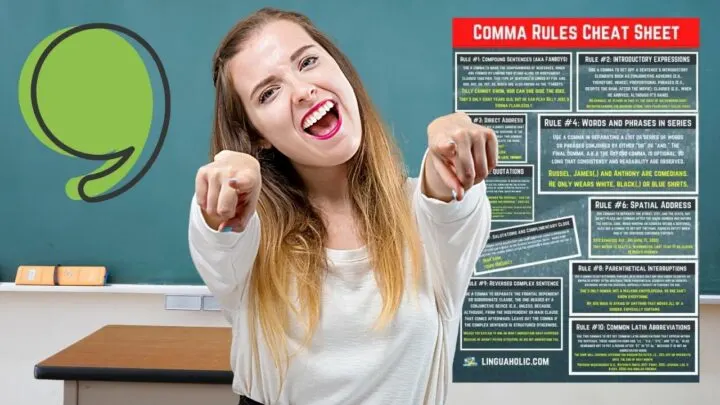Have you ever been stuck writing because you still need to double-check whether a comma is supposed to be inserted in between or among your words, phrases, and clauses?
(To be clear, I’m not talking about Santa, okay? And he’s only one, so you can’t pluralize his last name.)
And, have you ever wished of having an easy-to-digest comma cheat sheet that you can access anytime for a quick reference?
(By the way, repeated access could make you subconsciously remember these things minus the lengthy, rigorous reading, so long that you’re also constantly creating written outputs.)
Well, lo and behold, my fellow Linguaholic, because we’ve got these things laid out systematically to help you write more effectively and efficiently.
Comma 101: The fundamentals of the most notorious punctuation mark
Some people would suggest placing a comma where one naturally pauses in spoken conversations, but unfortunately, this catch-all rule does not apply to everyone.
We use commas for a whole heap of reasons. To mention a few, we use them to disambiguate a jungle of textual characters, to create prosody, and to emphasize ideas.
Or, we can simply bear in mind these three Rs that guide comma usage so we can do away with the technicality: readability, rhythm, and rhetoric.
We use commas to make texts readable so that the readers can comprehend our ideas completely and not get lost while reading, pretty much like road signs do.
We also use commas to create rhythm or prosody so that the text won’t be static or lifeless; appropriate rhythm also allows readers not to run out of oxygen when reading aloud.
And, thirdly, commas are used for rhetorical purposes to coax readers to read through the rest of your message and even prompt them to share your word with other people afterward.
Commas and the other punctuation marks were invented pretty much later than the alphabet, which tells us that they’ve been existing for rather functional reasons.
But, apart from commas’ utilitarian task on textual disambiguation, they are also known to help in expressing the poetic side of writers because of their ability to evoke emphasis on certain ideas.
In a nutshell, we use these tiny punctuation marks both for maintaining our sentences’ grammaticality and conveying the artsy side of the writer.
I think I’ve already said a lot, so why don’t I just show you a few examples for each?
Trust me, it’s neither rocket science nor astrophysics at all.
The grammatical use of commas
Can you tell me where the comma(s) go(es) in the following sentence? And, is it, or are they, even necessary at all?
Mom loves eating her kids and her dogs.
The sentence is perfectly grammatical because it’s not violating any syntactic rule and follows one of the conventional sentence structures in English.
But what about its whole unit of meaning?
Unless the writer is a psycho (and I’m not), the grammaticality will be fixed by adding commas appropriately after “eating” and “her kids,” in which the latter comma is also known as the Oxford comma.
Check this out.
Mom loves eating, her kids, and her dogs.
Commas are used for grammatical reasons when we apply them in separating a series or list of words, phrases, or clauses that appear consecutively in a sentence.
This is the most popular, the easiest, and the most functional use of commas in the realm of the English language. I’m sure you’ve heard of it.
Now, take a look at this other sentence.
Let’s cook Cindy.
More often than not, “Cindy” refers to either a female person or a pet’s name, so “Cindy” can’t really be your most ideal ingredient for dinner.
Now, let’s add the comma where it’s supposed to be.
Let’s cook, Cindy.
This comma rule applies to what we refer to as “direct address” in English, which is used when one aims to convey that he or she is “talking directly” to a person or any other message recipient rather than merely “reporting a statement.”
I hope I’m still making sense. And, I hope that I have made my point clearly enough, that is, commas do have the ability to save the lives of the people and animals that we love.
The art of using commas
And now, let’s also look at the stylistic side of comma usage by studying and comparing the next two sentences.
Can you tell me whether you agree with this statement?
A woman, without her man, is nothing.
If you’re nodding your head while reading, then you must be an alpha male who’s in love with the idea that masculinity inherently overthrows femininity.
But, how about the next sentence?
A woman, without her, man is nothing.
Didn’t the meaning and emphasis just shift three-sixty degrees?
I’m not sure which sentence is more striking for you, but I hope I’ve been able to convince you that commas do have the ability to calibrate the undertow of your messages, depending on how you want them to affect or be interpreted by your target audience.
Conclusion
Commas are pretty amazing, aren’t they?
If you’ve always been wondering what sets writer-minded people apart from others, I would like to assume that you have a decent grasp now.
That said, in this article, we have just touched upon a few fundamentals with regard to comma usage.
However, here at Linguaholic, we got a whole Comma Usage Cheat Sheet for you.
Feel free to download the sheet here!

Hey fellow Linguaholics! It’s me, Marcel. I am the proud owner of linguaholic.com. Languages have always been my passion and I have studied Linguistics, Computational Linguistics and Sinology at the University of Zurich. It is my utmost pleasure to share with all of you guys what I know about languages and linguistics in general.

